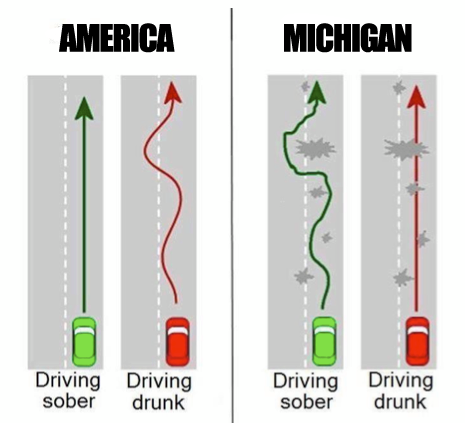https://www.washingtonpost.com/opinions/2022/03/10/pandemic-risky-driving-maybe-here-to-stay/
Opinion: Why bad driving habits from the pandemic might be here to stay
y'all drive like maniacs
In the streets emptied by the pandemic, policy paradoxes seemed to abound. In Monday’s column, I noted that during our great national sequestration, people became increasingly worried about crime, even though data showed that most sorts of crime had fallen. Here’s another: The roads seem much more dangerous, even though fewer people are driving.
With crime, it turned out that this was less of a paradox than it seemed; though fewer people were out in public, those who did go out were at higher risk of being victimized. Similarly, it really has gotten more dangerous to be on the road, or even near a road. Americans drove about 13 percent fewer miles in 2020, yet fatal crashes rose by 6.8 percent. And while we don’t have a comprehensive tally of fatalities in 2021, what data we do have suggests that they are still rising, even in D.C., where speed limits were actually lowered during the pandemic.
Preliminary analysis suggests that this was driven, at least in part, by a surge of risky driving behaviors: more speeding, more driving under the influence, less seat belt use. Given the timing, it seems almost certain that this shift has something to do with pandemic conditions. But why would a pandemic cause people to start risking their lives on the road?
A number of theories have been suggested for this phenomenon, from the lure of wide-open roads to decreased traffic enforcement to pandemic stress. But while that might explain the speeding, or the intoxication, it doesn’t really explain the seat belts. For that, we have to turn to recent research from the AAA Foundation for Traffic Safety, which suggests that this is what the roads look like when the most risk-averse people decide to stay home.
The foundation ran a survey of drivers over a month in the fall of 2020, asking people about risky behaviors such as speeding or driving under the influence. It also asked whether people had increased, held steady or reduced their driving since the beginning of the pandemic. Most people, their surveys indicate, decreased their driving, while only 4 percent said they were driving more. But that 4 percent was quite different from the group that stayed off the roads; younger and more likely to be male, as well as more likely to say they had recently texted while driving, run a red light, driven without a seat belt or yes, driven drunk.
It’s true that many people refuse to respond to survey-takers, and those who do don’t always give accurate answers. But these results are broadly in line with government reports about risk-taking behavior. And it also just seems to make sense: Of course older and more risk-averse people stayed home, while fearless (reckless?) younger men took advantage of the suddenly open roads.
If true, that still leaves one mystery to be explained: Why have things stayed bad (indeed, gotten worse) as the rest of us slowly returned to the roads? Perhaps it really is just pandemic stress. But another, more troubling possibility is that changing the mix of who was driving changed the whole culture of American roads, making it less law-abiding and more aggressive.
While our driving is broadly governed by laws, our cultural assumptions about what’s permitted also matter a great deal: how far over the speed limit one dares go; how to treat drivers who want to get into your lane. As a born-and-bred New Yorker, I had trouble the first time I motored around Omaha, because at first I didn’t realize that the seemingly erratic drivers I saw were actually slowing down to let me merge. I’m sure Omaha drivers have at least as much trouble trying to slide past the cabs on Ninth Avenue.
As my example suggests, we take our cues about what is acceptable from the drivers around us. If the drivers around us are speeding, we go faster; if they are aggressively cutting off other drivers, so will we (or risk spending eternity in the middle lane). That’s why so much effort has gone into not just changing the law, but changing cultural norms about such things as wearing seat belts and driving after drinking. The pandemic may have undone some of that good work.
Nor are those effects necessarily limited to American roads. The sudden disappearance of risk-averse and rule-loving people from public spaces might also help explain other negative cultural shifts we’ve seen, from rising crime to air rage. That won’t be the only explanation — air travel, for example, is genuinely more unpleasant than it was three years ago. But it might be part of what’s going on. Which raises the possibility that these developments will be more of a new normal than a pandemic aberration.
Culture has a certain absorptive quality; when new people join a group, they tend to adopt its folkways. As the risk-averse return, slowly and fitfully, to public life, they could end up assimilating into the now-dominant culture that is more aggressive and less deferential to authority. And if we don’t like the results, we might face a long, hard road back to where we were.
